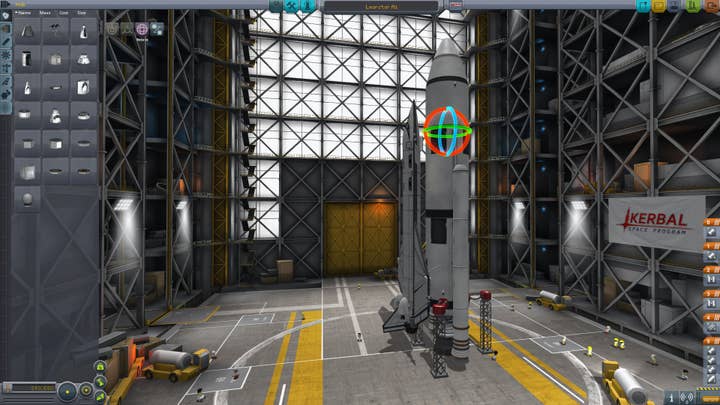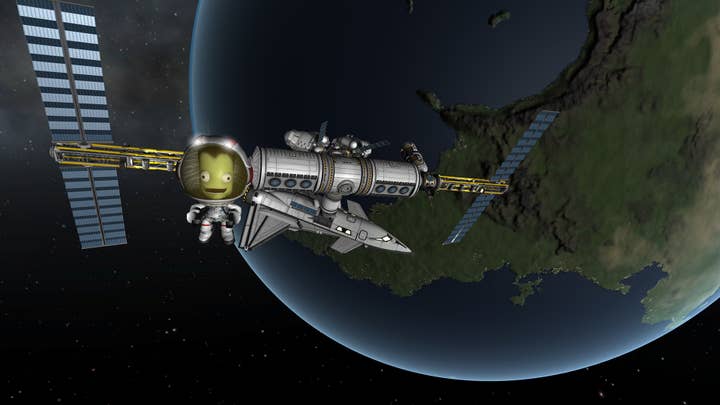Star Theory's shot beyond the Mun with Kerbal Space Program 2
Creative director Nate Simpson on the challenges of grounding the interstellar sequel in reality while adding accessibility
Though Star Theory sounds like the perfect name for a developer making a game about sending things into space, it might have alarmed some fans of Kerbal Space Program to see the sequel taken on by a new studio.
Fortunately, this isn't Star Theory's first journey to, well, the stars. The Washington-based studio previously known as Uber Entertainment has existed since 2008, and has worked on PC, mobile and PlayStation VR titles -- including the real-time strategy game Planetary Annihilation. Uber Entertainment voted to change its name recently, both to get away from unfortunate confusion with the ride-sharing company and to tie itself more closely with Kerbal, which is both its biggest project yet and a game planned to launch while its predecessor remains active, updated, and supported.
At PAX West, Kerbal Space Program 2 creative director Nate Simpson helps me puzzle out the complex web the Kerbal IP is currently in. The original game was developed by Mexican studio Squad and launched publicly in 2011, with Take-Two Interactive acquiring the IP in 2017. Squad has continued to work on the game with ongoing updates, and Take-Two's Private Division label published its enhanced edition. Those ongoing updates from Squad will continue, says Simpson, which is at least part of why Take-Two and Private Division wanted to hand off the sequel to a different studio.
"We're hoping we have another decade ahead of us working with this new platform we've created for Kerbal Space Program 2"
"The original game... has an incredibly robust modding community and very passionate fans of its own," Simpson says. "They've continued to release expansion content... and I don't think Private Division wanted to interrupt that in any way. So they made the decision to bring in a new team to start working on the sequel while continuing to support the original game. As I understand it, more than one studio was given the opportunity to make it."
Making a sequel naturally means trying to better the original, and Simpson says that the technology available eight years after the original release means improved graphics, better physics, mod support, multiplayer, and other desirable features will be a given. But despite all these upgrades, Simpson isn't worried that Kerbal 2 will harm the existing community for the first game.
"The original game is on year eight now, and it's thriving," he says. "It's as vibrant a community as it's ever been, and we're hoping we have another decade ahead of us working with this new platform we've created for Kerbal Space Program 2. That's kind of the main event for us, is it needs to be a platform. It's stable, it's extendable, it's scalable, it's moddable, all those things are built into the core design of the game so that we can take it to places we can't even envision right now."

Simpson tells me that every member of the team working on Kerbal 2 is a big fan of the first game, something that's been critical in making a sequel for a game with such an involved community. Though there are some updates that Simpson says just about everyone agrees need to be in a sequel, careful listening and consideration are required, especially when taking on an IP from another studio.
"We ask ourselves a lot of questions," he says. "Any new thing that comes into the game at the very least has to either advance the gameplay in some meaningful way by making the game more fun or interesting, or it needs to make the game more immersive by giving it an extra layer of realistic varnish.
"You have to knock down your ego to make sure that you're not pushing your way of playing the game on a community that's found infinite ways to play"
"The ideas inside this game are so big that it is impossible for me to know personally all the things that could possibly be done in the game. So I've had to outsource my intelligence to a lot of people around me on the team and out in the community to remind me of what needs to happen in the game in some sense. I play the game a certain way and I'm extremely well-acquainted with playing the game a certain way, but when somebody comes in and says, 'I don't even bother with flying to the Mun, I just fly space planes.'
"There are so many ways to play this game, and you need to constantly have your ears open for those perspectives to make sure we're going to be accommodating all these different play styles. And you have to knock down your ego a little bit to make sure that you're not pushing your way of playing the game on a community that's found infinite ways to play the game."
The community isn't the only place Simpson and Star Theory are going for feedback. Star Theory is made up of game developers, not aerospace engineers, and yet Kerbal is known for being largely grounded in reality in its physics and engineering simulations. That means consulting lots of scientists, Simpson says, and being realistic about the limits of one's own knowledge.
"It's been a pretty humbling experience because I recognize that there is no way my single mind can encompass all the knowledge that goes into making a project like this successful," he says. "But I've learned to outsource intelligence to a lot of people who are much smarter than I am. So we have a former aerospace engineer on our engineering staff, and if we're going to be talking about aerodynamics, he's the guy to talk to."
But though the game is grounded in reality, the flavor added by the silly Kerbal mascots and frequently absurd physics allows Star Theory to be a bit playful around the specifics.
"The Kerbals are really part of the flavor because they're there to remind you not to take things too seriously," Simpson says. "You're supposed to laugh when you fail, and that's critical to learning how to play the game. You need to try and mess up and then slightly alter your design and try again and then, 'Oh my gosh, I'm in orbit!' That's the game in a nutshell.
"But it also has the extreme opposite influence of needing to be plausible space technology, and we take that very seriously. We work with subject matter experts to make sure everything we've added to the game is at least rooted in some sort of scientific story. So the new fuel types -- whether it's metallic hydrogen or whatever -- that's all stuff that comes from real scientific papers we've read. We care enough to spend a lot of time trying to come to some design that is defensible at least."

The idea of messing up, watching something explode or fall to pieces, and then start over again has always been important to Kerbal Space Program, and it was even given a place of prominence in a trailer the team showed to interested crowds at PAX West. But Simpson freely admits that the first game may have had a bit too much failure for many, to the point of being inaccessible.
"We care enough to spend a lot of time trying to come to some design that is defensible at least"
Simpson tells me that a common story he hears among friends and family is that watching YouTube videos of the original Kerbal is enjoyable, but playing the game itself feels too overwhelming to try. That's something he and the team aim to fix in the sequel by including more tutorials and better types of guidance at appropriate points in the game. The goal isn't to make the game easier, but rather to help players understand the tools at their disposal so they can comfortably experiment.
"In designing the tutorials we had to really make a clear distinction between constructive failure and frustrating failure," he says. "Constructive failure is when you fail but you're able to ascertain why you failed. Then you can make a meaningful decision on your next design. But failure that remains mysterious, that causes you to make the same mistake over and over again, that's not fun failure.
"We've found that as we tutorialize a lot of the core concepts of the game and teach them in a more intuitive way using animations and things like that, presenting you with this information when it is relevant to your interests -- we're finding that people are actually taking to it like a duck to water, people who don't necessarily bring that subject matter expertise to the experience right out of the gate.
"And it's been really important for us not to make the game easier. Finally we have an opportunity to build a ramp from the ground to the top of the cliff that represents the first-time user experience in the old game. Now we want it to be a slightly gentler passage into those core concepts, because once you have those tools at your disposal the game is super addictive. The things you can do with this game are literally limitless, but you've got to get over that first speed bump or you're lost."
"We haven't actually come across a person who was unable to fly to the Mun after experiencing our new tutorial."

